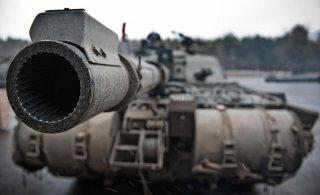Why Russia's Cold War Monster Tank Was 60 Tons of Total Failure
Why the Object 279 tank was already obsolete before it even got started.
In a war that never happened, formations of heavy and rather odd-looking Soviet tanks would have powered through atomic explosions in breakthrough attacks into West Germany.
Enter the Object 279 tank, a curious oddity from the late 1950s which was obsolete — despite its design principles deliberately reflecting the fear of a nuclear battlefield — by the time it was produced.
It was certainly not a success, as the Soviet Union only manufactured a handful of prototypes.
But the fact that it appeared at all is indicative of an obsession among a small number of Red Army military planners dating back to World War II. As the Nazis and Soviets battled for hegemony, both sides fielded increasingly heavier tanks — with bigger guns — which could absorb fire while destroying their heavily-armored enemies at long range.
Medium tanks, such as the legendary T-34, would ultimately pioneer the main battle tanks which armies deploy today. However, the Kremlin continued building thousands of heavy tanks into the 1960s until Soviet leader Nikita Khrushchev effectively put a stop to it.
The Object 279 was part of this tradition.
The Object 279’s most visible features include the sharp, saucer-shaped chassis and four distinct, enormous tracks. The latter was to give the 60-ton tank more traction in difficult or soft terrain, always a problem for heavier tanks prone to bogging down. A 1,000-horsepower engine powered the beast.
The design’s obvious downside? One could only imagine the difficulty repairing the two inner tracks running underneath the chassis’ belly, let alone the complex transmission. Equally bizarre is the shape of the chassis to protect the vehicle and its four crew members from shock waves generated by an exploding nuclear bomb.
The Object 279 came with serious armor — 319 millimeters thick in the turret and 269 millimeters at the thickest point in the hull, significantly greater than the far more widespread T-72 which entered service in the 1970s.
An impressive, stabilized 130-millimeter rifled cannon and 14.5 millimeter machine gun rounded out the turret.
But the quad-tracked juggernaut’s technical specifications are somewhat moot, as the prototypes came at the worst possible time.
Back up. During World War II, the Soviets refined their heavy tank designs, culminating in the IS-2 — an intimidating and impressive vehicle which entered service in 1944. IS-2s most notably spearheaded the Red Army assault into Berlin, blasting German Tiger tanks and reducing fortified positions into rubble.
The success of the IS-2 was never replicated again in a Soviet heavy tank. A follow-up, the IS-3, was a nightmare to maintain and underwent near constant upgrades to resolve numerous design problems in the welding and wheel bearings.
“Even in 1946 a committee was formed to fix the problems of what had become the flagship Soviet tank, and to prevent Western intelligence agencies from finding out how bad the tank really was,” Stephen Sewell wrote in a 2002 edition of Armor magazine.
“Militarily the IS-3 offered little more than propaganda value, as it was an embarrassment and seldom offered to Soviet allies.”
When the IS-3 did find itself outside the USSR, it rarely saw combat. Protesters during the 1956 Hungarian uprising destroyed a few, and the Israelis annihilated dozens of them in Egyptian service in 1967.
The IS-4 hardly fared better, and another tank called the T-10 endured a torturous development period as capable medium tanks such as the T-55 and the soon-to-come T-64 competed for budget dollars.
In reality, classic heavy tanks stopped making sense by the mid-1950s. Speedy, maneuverable and reliable tanks — with new high-powered guns — would win the wars of the future. Devastating guided missiles capable of punching through heavy armor had also begun entering service.
Khrushchev, who loved missiles, had enough of the Soviet army’s penchant for heavy tanks.
“If tanks were going to remain, they must fire missiles and use a drum-canister inside the tank for storage. [Tank designer L.N.] Kartsev argued that this was a dumb idea, and that the USSR was more likely to need gun tanks than missiles,” Sewell wrote, referencing a 1960 conversation between the two men.
“While he and Khrushchev argued, it was apparent that Khrushchev was listening to him. But after seeing the old-fashioned T-10, Khrushchev was adamant: no more heavy tanks.”
The Object 279 died with them. But in an irony which its designers would have appreciated, today’s main battle tanks — what were once medium tanks — have grown a lot heavier.
This first appeared in WarIsBoring here.
Image: Creative Commons/Flickr.

